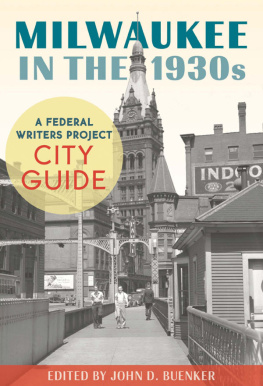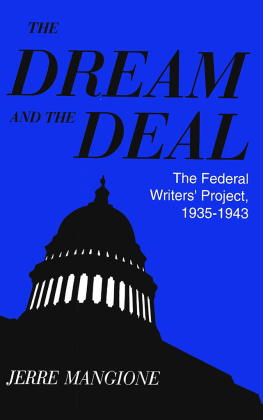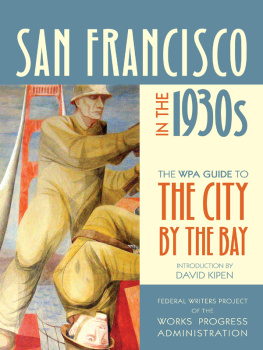Federal Writers Project - New York panorama: essays from the 1930s
Here you can read online Federal Writers Project - New York panorama: essays from the 1930s full text of the book (entire story) in english for free. Download pdf and epub, get meaning, cover and reviews about this ebook. City: New York (N.Y.);New York (State);New York, year: 2018, publisher: Dover Publications, genre: Art. Description of the work, (preface) as well as reviews are available. Best literature library LitArk.com created for fans of good reading and offers a wide selection of genres:
Romance novel
Science fiction
Adventure
Detective
Science
History
Home and family
Prose
Art
Politics
Computer
Non-fiction
Religion
Business
Children
Humor
Choose a favorite category and find really read worthwhile books. Enjoy immersion in the world of imagination, feel the emotions of the characters or learn something new for yourself, make an fascinating discovery.

- Book:New York panorama: essays from the 1930s
- Author:
- Publisher:Dover Publications
- Genre:
- Year:2018
- City:New York (N.Y.);New York (State);New York
- Rating:5 / 5
- Favourites:Add to favourites
- Your mark:
- 100
- 1
- 2
- 3
- 4
- 5
New York panorama: essays from the 1930s: summary, description and annotation
We offer to read an annotation, description, summary or preface (depends on what the author of the book "New York panorama: essays from the 1930s" wrote himself). If you haven't found the necessary information about the book — write in the comments, we will try to find it.
Federal Writers Project: author's other books
Who wrote New York panorama: essays from the 1930s? Find out the surname, the name of the author of the book and a list of all author's works by series.
New York panorama: essays from the 1930s — read online for free the complete book (whole text) full work
Below is the text of the book, divided by pages. System saving the place of the last page read, allows you to conveniently read the book "New York panorama: essays from the 1930s" online for free, without having to search again every time where you left off. Put a bookmark, and you can go to the page where you finished reading at any time.
Font size:
Interval:
Bookmark:
The Federal Writers' Project
PRESENTS
NEW YORK
PANORAMA

ESSAYS FROM THE 1930s

DOVER PUBLICATIONS, INC.
MINEOLA, NEW YORK
Bibliographical Note
This Dover edition, first published in 2018, is an unabridged republication of the work originally published as New York Panorama: A Companion to the WPA Guide to New York City by Random House, New York, in 1938.
Library of Congress Cataloging-in- Publication Data
Names: Federal Writers' Project.
Title: New York panorama : essays from the 1930s the Federal Writers' Project.
Description: Mineola, N.Y. : Dover Publications, Inc., 2018. | Originally published: New York : Random House, 1938, under the title, New York Panorama: a companion to the WPA guide to New York City.
Identifiers: LCCN 2017054112| ISBN 9780486821009 | ISBN 0486821005
Subjects: LCSH: New York (N.Y.)Guidebooks.
Classification: LCC F128.18 .N435 2018 | DDC 917.47/104dc23
LC record available at https://lccn.loc.gov/2017054112
Manufactured in the United States by LSC Communications
82100501 2018
www.doverpublications.com

I. CONTEMPORARY SCENE
Metropolis and Her Children

T HE RUMOR of a great city goes out beyond its borders, to all the latitudes of the known earth. The city becomes an emblem in remote minds ; apart from the tangible export of goods and men, it exerts its cultural instrumentality in a thousand phases: as an image of glittering light, as the forcing ground which creates a new prose style or a new agro-biological theory, or as the germinal point for a fresh technique in metal sculpture, biometrics or the fixation of nitrogen. Its less ponderable influence may be a complex of inextricable ideas, economic exchanges, associations, artifacts: the flask of perfume which brings Fifth Avenue to a hacienda in the Argentine, the stencil marks on a packing case dumped on the wharf at Beira or Reykjavik, a flurry of dark-goggled globe-trotters from a cruise ship, a book of verse
Under the stone I saw them flow
express Times Square at five o'clock
eyes set in darkness
read in a sheepherder's hut in New South Wales, or a Harlem band playing Young Woman's Blues from a phonograph as the safari breaks camp in Tanganyika under a tile-blue morning sky as intensely lighted as the panorama closed by mountains in the ceiling dome of the African section at the American Museum of Natural History.
The orbit of such a world city as New York also intersects the orbits of other world cities. New York, London, Tokyo, Rome exchange preferred stocks and bullion, ships' manifests and radio programsin rivalry or well-calculated friendship. During the 1920's, for example, a jump spark crackled between New York and Paris. The art of Matisse, Derain, Picasso commanded the Fifty-Seventh Street market. The French developed a taste for le jazz and le sport; in an atmosphere of war debts and the Young Plan, the Americanization of Europe was mentioned. Paris, capital of the Valutaschweine, became the bourne of good and gay New Yorkers, the implicit heroine of a comedy by Philip Barry or a novel by Ernest Hemingway. The French replied, though not always in kind. Georges Duhamel pronounced a jeremiad against the machine apocalypse in America and Paul Morand, an amateur of violence, explored the sensational diversity of New York. These were symptomatic. The comments of Jules Romains went deeper and established fixed points for contrast with a later period.
All the rays of force alive in the modern world move inward upon the city, and the burning glass of its attraction concentrates them in the flame that is New York. Historically, it has been to an exceptional degree a city of accumulation: its methods promotion and commerce, its principle aggrandizement. About a nucleus of Dutch and Englisheven French Huguenotsettlers it subsequently collected swarm after swarm of Irish, German, Italian, Jewish and Russian immigrants, a proportion of other nationalities, and Americans of many stocks from the seaboard and the interior. For the most part, those immigrants who remained in the city were compacted into districts especially suited to their exploitation, districts as verminous and sunless as the Cloaca Maxima. Here, in dwellings that reproduced the foetor of the slave ship in all but the promise of eventual liberty held out to the more intelligent or ruthless, they formed a crawling agglomeration. This was the frontier of New York and the grim apotheosis of the frontier in the United States, preserved almost untouched into the third decade of the 20th century.
The shawled refugees from European want and oppression, most of whom crossed the ocean in immigrant ships under conditions of the utmost squalor, were also transported by a succession of great New York trade vessels: the Black Ball and other Western Ocean packet lines, the world-ranging Donald McKay clippers, the first wood and iron steamships. These were conned through the Narrows by men off the superb Sandy Hook pilot schooners which had been worked out from the designs of Isaac Webb in the 1830's, the hollow-entrance experiments of Griffiths in the 1840's, and the later masterly work of George Steers in such craft as the Moses H. Grinnell and the America, for which the America's Cup was named. Great numbers of immigrants and New Yorkers moved inland by way of the Hudson River sloops and steamboats, the Conestoga wagons, the Erie Canal barges and the railroads. Very early, therefore, the history of New York began to be a history of the successive phases in American transportation. As its lines of influence spread out into the interior, thickened and were fixed, it became more and more the commanding American city, the maker or merchant of dress silks and pannikins and spices, wines and beds and grub hoes. Long before the paramount age of sail ended, New York had taken on its alternate character as a great two-way transfer point and classification yard for men and goods and ideas moving between the other countries of the world and the great central plain of America. It has consolidated and enlarged this character with a multiplicity of functions which help to determine its position as the first city of the Western Hemisphere.
Approach to the City
For the American traveler coming home from Cape Town or St. Moritz or the Caribbean, and for those others who converge upon the city from Chicago and El Paso and Kildeer and Tonopah, New York has a nearer meaning. It is, in whatever sense, a substitute home towna great apartment hotel, as Glenway Wescott wrote, in which everyone lives and no one is at home. In other eyes it may be a state fair grown to magnificence, a Main Street translated into the imperial splendor of Fifth Avenue. To such travelers the city is a coat of many colorsbecoming to each, but not quite his own. It is both novelty and recognition that pleases him: the novelty of its actual and amazing encompassment, the recognition of great shafts and crowds and thoroughfares remembered from a hundred motion pictures, rotogravures and advertisements.
Next pageFont size:
Interval:
Bookmark:
Similar books «New York panorama: essays from the 1930s»
Look at similar books to New York panorama: essays from the 1930s. We have selected literature similar in name and meaning in the hope of providing readers with more options to find new, interesting, not yet read works.
Discussion, reviews of the book New York panorama: essays from the 1930s and just readers' own opinions. Leave your comments, write what you think about the work, its meaning or the main characters. Specify what exactly you liked and what you didn't like, and why you think so.





